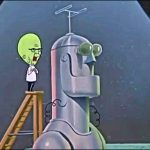

We enter the 1950’s this week, where the clatter of robotic tin still continues to result in the clanking of coin for producers and distributors. The lion’s share of mechanized action goes to Warner Brothers this week – although the lion at MGM gets his paws in for one notable visit with Tom and Jerry.
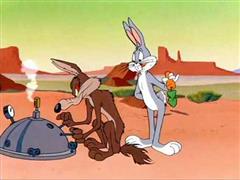 Operation: Rabbit (Warner, Bugs Bunny, 1/19/52 – Charles M. (Chuck) Jones, dir.), marks the first summit meeting between Bugs Bunny and Wile E. Coyote – and the first time Wile E. is given a voice. His speaking personality is one full of self-conceit, as he introduces himself formally at Bugs’ rabbit hole by means of a folding front door, presenting his business card – “Wile E. Coyote – Genius”. He explains that Bugs needn’t try to run away, as Wile E. is more cunning, muscular, faster, and larger – “and I’m a genius!” Bugs is given the customary “two minutes to say your prayers.” Bugs remains unflappable, responding, “I’m sorry Mac. The lady of the house ain’t home – and besides, we mailed you people a check last week”, then slams the door in Wile E.‘s face. Folding up his door, the coyote ponders, “Why do they always want to do it the hard way?
Operation: Rabbit (Warner, Bugs Bunny, 1/19/52 – Charles M. (Chuck) Jones, dir.), marks the first summit meeting between Bugs Bunny and Wile E. Coyote – and the first time Wile E. is given a voice. His speaking personality is one full of self-conceit, as he introduces himself formally at Bugs’ rabbit hole by means of a folding front door, presenting his business card – “Wile E. Coyote – Genius”. He explains that Bugs needn’t try to run away, as Wile E. is more cunning, muscular, faster, and larger – “and I’m a genius!” Bugs is given the customary “two minutes to say your prayers.” Bugs remains unflappable, responding, “I’m sorry Mac. The lady of the house ain’t home – and besides, we mailed you people a check last week”, then slams the door in Wile E.‘s face. Folding up his door, the coyote ponders, “Why do they always want to do it the hard way?
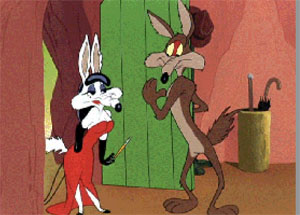 Wile E. engages in drawing up blueprints and constructing various inventions to capture Bugs. Among them is an “Explosive Decoy”- a mechanical robot rabbit in a sexy bikini, loaded with explosives with a timer device. Wile E. sets the machine in motion, but is interrupted by a knock at the door of his cave. There stands a ravishing female coyote, in strapless evening gown and with long black flowing wig – who just happens to be ticking. A wire extends from the tail of the “dame”, unseen to Wile E. The smitten coyote seizes the femme in an embrace, spouting words of romance into her ear. “Ah, my darling. How beautiful you are. How devastating. How lucky! Little did you dream that one day you would marry a genius.” The camera follows the wire from the mechanical coyote back to Bugs’ rabbit hole, where Bugs waits with a dynamite plunger control, to activate his own load of explosives inside the decoy. “Fight fire with fire, I always say”, says Bugs, pressing the plunger handle. A blast is heard from Wile E.’s cave. There, the charred, black-eyed coyote stands hand in hand with the head and paws of the robot *the remainder of its frame only held together by a few strands of wire), singing what sounds like a drunken chorus of “Here Comes the Bride.” At that moment, an alarm timer is heard – as the time-bomb mechanism of the coyote’s own rabbit decoy is activated. “Oh, no!” gasps Wile E., some smoke coming out of his lips from the blasting he has already taken. He races for the rabbit robot, picks it up, and poises to hurl it out the cave door, when a second explosion obliterates the scene, sparing us the grizzly detail of its aftermath, by merely dissolving to the next master plan.
Wile E. engages in drawing up blueprints and constructing various inventions to capture Bugs. Among them is an “Explosive Decoy”- a mechanical robot rabbit in a sexy bikini, loaded with explosives with a timer device. Wile E. sets the machine in motion, but is interrupted by a knock at the door of his cave. There stands a ravishing female coyote, in strapless evening gown and with long black flowing wig – who just happens to be ticking. A wire extends from the tail of the “dame”, unseen to Wile E. The smitten coyote seizes the femme in an embrace, spouting words of romance into her ear. “Ah, my darling. How beautiful you are. How devastating. How lucky! Little did you dream that one day you would marry a genius.” The camera follows the wire from the mechanical coyote back to Bugs’ rabbit hole, where Bugs waits with a dynamite plunger control, to activate his own load of explosives inside the decoy. “Fight fire with fire, I always say”, says Bugs, pressing the plunger handle. A blast is heard from Wile E.’s cave. There, the charred, black-eyed coyote stands hand in hand with the head and paws of the robot *the remainder of its frame only held together by a few strands of wire), singing what sounds like a drunken chorus of “Here Comes the Bride.” At that moment, an alarm timer is heard – as the time-bomb mechanism of the coyote’s own rabbit decoy is activated. “Oh, no!” gasps Wile E., some smoke coming out of his lips from the blasting he has already taken. He races for the rabbit robot, picks it up, and poises to hurl it out the cave door, when a second explosion obliterates the scene, sparing us the grizzly detail of its aftermath, by merely dissolving to the next master plan.
In the end, Wile E., all devices having resulted in him being nearly blasted to bits, returns to Bugs’ hole with his portable door. He is now a blackened wreck, and in a war-weary voice, performs a re-introduction. “Allow me to Introduce myself. My name is Mud.” The coyote faints away on the spot, as Bugs asides to the audience, “And remember, Mud spelled backwards is Dum!”
This version is slightly sped up (time compressed):
 Water, Water, Every Hare (Warner, Bugs Bunny, 4/19/52 – Charles M. (Chuck) Jones, dir.) is basically an excuse to bring Gossamer back to the screen, first seen in “Hair-Raising Hare”, with some near-lifting of old material, but a new mad scientist and a few scenes bordering on the surreal. The robot of this cartoon performs no action whatsoever, but serves as a plot point to progress the action, The film begins with a different means of transporting Bugs to a mad-scientist’s castle. A flood is sweeping over the forest – and pouring gallons of water into the open mouth of Bugs’ rabbit hole. Bugs is sound asleep, and unknowingly, finds himself underwater. Hardly opening his eyes, he gets up and groggily walks across the room to his water cooler – to take a drink – even though he could obtain the same result by just opening his mouth. He returns to bed, where his whole mattress floats to the surface and out the rabbit hole, being swept down-current into the river. (Talk about your water bed.) It floats to a point where the river ends in a steep waterfall, just passing the scientist’s castle. (We can tell who the castle’s occupant is by a flashing neon sign on its wall, which alternates between reading “Evil Scientist” and “Boo”.) The genius within is a green-complexioned mini-version of Vincent Price, working over a king-size metal robot about twenty times his size. “So nearly complete. So nearly perfect. If you only had a living brain.” At that moment, he spots Bugs floating by through a turret window. Producing a rod and reel, the scientist casts a line out the window, and hooks Bugs’ blanket, lifting the rabbit into the castle with it, just short of plummeting over the waterfall.
Water, Water, Every Hare (Warner, Bugs Bunny, 4/19/52 – Charles M. (Chuck) Jones, dir.) is basically an excuse to bring Gossamer back to the screen, first seen in “Hair-Raising Hare”, with some near-lifting of old material, but a new mad scientist and a few scenes bordering on the surreal. The robot of this cartoon performs no action whatsoever, but serves as a plot point to progress the action, The film begins with a different means of transporting Bugs to a mad-scientist’s castle. A flood is sweeping over the forest – and pouring gallons of water into the open mouth of Bugs’ rabbit hole. Bugs is sound asleep, and unknowingly, finds himself underwater. Hardly opening his eyes, he gets up and groggily walks across the room to his water cooler – to take a drink – even though he could obtain the same result by just opening his mouth. He returns to bed, where his whole mattress floats to the surface and out the rabbit hole, being swept down-current into the river. (Talk about your water bed.) It floats to a point where the river ends in a steep waterfall, just passing the scientist’s castle. (We can tell who the castle’s occupant is by a flashing neon sign on its wall, which alternates between reading “Evil Scientist” and “Boo”.) The genius within is a green-complexioned mini-version of Vincent Price, working over a king-size metal robot about twenty times his size. “So nearly complete. So nearly perfect. If you only had a living brain.” At that moment, he spots Bugs floating by through a turret window. Producing a rod and reel, the scientist casts a line out the window, and hooks Bugs’ blanket, lifting the rabbit into the castle with it, just short of plummeting over the waterfall.
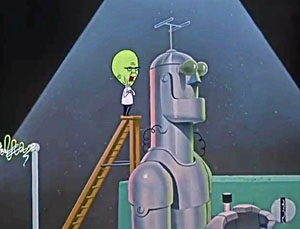 The scientist lays Bugs on the lid of one in a row of mummy sarcophaguses, taking a measurement of the rabbit’s cranium size. “A wee bit small – but it will have to do.” Bugs, still sound asleep, feels a chill, and reaches for his blanket – instead grabbing the wrappings from a mummy in the next box, which he pulls on top of himself. Then Bugs opens his eyes. The sight of the mummy, the scientist, and the robot puts Bugs Into a state of screaming shock, as he runs in panic down the labyrinth of castle corridors. “Delays. Nothing but delays”, mutters the scientist, turning to his backup – the locked chamber of Gossamer (here referred to by the scientist as “Rudolf”). The scientist promises the red hairy monster a reward of a spider goulash if he will return the rabbit. A sequence from “Hair-Raising Hare” is almost duplicated, with Bugs cornered between the monster and a crocodile pit, but turning the tables by assuming the manner of a beauty salon hair stylist (in the original, he was a manicurist), and talking Gossaer into a “permanent”, using firecrackers instead of hair rollers. The usual array of monster-chases-rabbit gags fill the cartoon, climaxing with a chase through the scientist’s experimental chemistry lab. Obtaining a bottle of Vanishing Fluid from a shelf, Bugs becomes invisible – then pours onto Gossamer the contents of a second bottle, marked “Reducing Oil”. The ten-foot tall monster is reduced to a height of four inches, with his roar diminished to an “eep”, and stomps out of the shot in frustration, returning a second later in hat and coat and with traveling bag, leaving the same exit sign as the robot of “House Hunting Mice” on the door of a mousehole in the wall, reading “I quit.” The mouse within the hole is ejected, and, having seen the amazing sight of a four-inch monster, removes a bottle of booze from an unseen pocket, dropping it on the floor. “I quit too!”, he tells the audience, then zips out of frame. Bugs suddenly finds himself becoming visible again – as the mad scientist pours another bottle of fluid upon him, labeled “Hare Restorer”. He beckons Bugs to be a nice rabbit and let him have his brain. “Sorry Mac, but I need what little I’ve got.” The scientist tosses an axe, but misses, smashing instead a large bottle of ether. A surreal slow-motion chase follows, down the steps of the castle into the woods. Bugs extends a foot, and trips the scientist in slow motion. The scientist even falls slowly, muttering “Nighty-night”. Bugs drifts in his slowed mode toward home, but also trips on a stone. “Nighty-night”, he echoes, falling into slumber – as a rivulet of the flood water floats him back into the mouth of his rabbit hole. Bugs finally awakens in his flooded bedroom, raising his head just above water level, trying to get his bearings. He concludes of the whole affair, “Musta been a nightmare.” Just at that moment, the miniature Gossamer floats by in a tiny rowboat, and in a miniature, squeaky voice, responds, “Oh yeah! That’s what you think!”
The scientist lays Bugs on the lid of one in a row of mummy sarcophaguses, taking a measurement of the rabbit’s cranium size. “A wee bit small – but it will have to do.” Bugs, still sound asleep, feels a chill, and reaches for his blanket – instead grabbing the wrappings from a mummy in the next box, which he pulls on top of himself. Then Bugs opens his eyes. The sight of the mummy, the scientist, and the robot puts Bugs Into a state of screaming shock, as he runs in panic down the labyrinth of castle corridors. “Delays. Nothing but delays”, mutters the scientist, turning to his backup – the locked chamber of Gossamer (here referred to by the scientist as “Rudolf”). The scientist promises the red hairy monster a reward of a spider goulash if he will return the rabbit. A sequence from “Hair-Raising Hare” is almost duplicated, with Bugs cornered between the monster and a crocodile pit, but turning the tables by assuming the manner of a beauty salon hair stylist (in the original, he was a manicurist), and talking Gossaer into a “permanent”, using firecrackers instead of hair rollers. The usual array of monster-chases-rabbit gags fill the cartoon, climaxing with a chase through the scientist’s experimental chemistry lab. Obtaining a bottle of Vanishing Fluid from a shelf, Bugs becomes invisible – then pours onto Gossamer the contents of a second bottle, marked “Reducing Oil”. The ten-foot tall monster is reduced to a height of four inches, with his roar diminished to an “eep”, and stomps out of the shot in frustration, returning a second later in hat and coat and with traveling bag, leaving the same exit sign as the robot of “House Hunting Mice” on the door of a mousehole in the wall, reading “I quit.” The mouse within the hole is ejected, and, having seen the amazing sight of a four-inch monster, removes a bottle of booze from an unseen pocket, dropping it on the floor. “I quit too!”, he tells the audience, then zips out of frame. Bugs suddenly finds himself becoming visible again – as the mad scientist pours another bottle of fluid upon him, labeled “Hare Restorer”. He beckons Bugs to be a nice rabbit and let him have his brain. “Sorry Mac, but I need what little I’ve got.” The scientist tosses an axe, but misses, smashing instead a large bottle of ether. A surreal slow-motion chase follows, down the steps of the castle into the woods. Bugs extends a foot, and trips the scientist in slow motion. The scientist even falls slowly, muttering “Nighty-night”. Bugs drifts in his slowed mode toward home, but also trips on a stone. “Nighty-night”, he echoes, falling into slumber – as a rivulet of the flood water floats him back into the mouth of his rabbit hole. Bugs finally awakens in his flooded bedroom, raising his head just above water level, trying to get his bearings. He concludes of the whole affair, “Musta been a nightmare.” Just at that moment, the miniature Gossamer floats by in a tiny rowboat, and in a miniature, squeaky voice, responds, “Oh yeah! That’s what you think!”
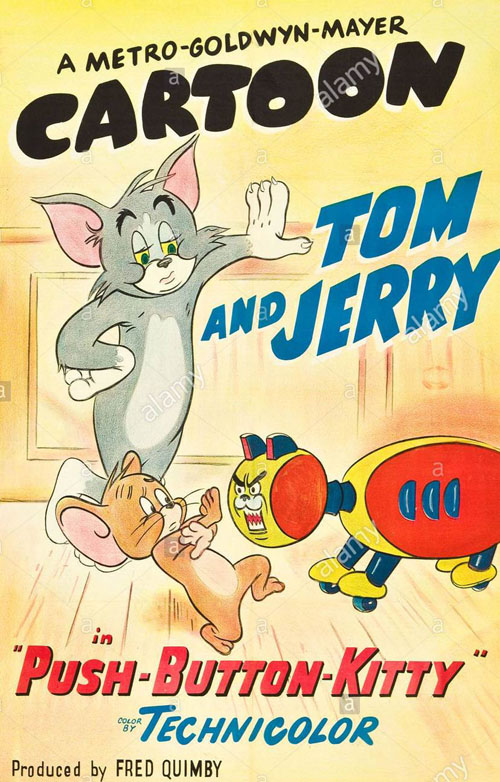 Push Button Kitty (MGM, Tom and Jerry, 9/6/52 – William Hanna/Joseph Barbera, dir.) – Tom is in his laziest of moods. The most energy he’ll muster is to raise one leg at a time to let Mammy sweep the floor underneath him, while he continues to snooze on a comfortable pillow. Jerry saunters by with a piece of cheese, and goes entirely unmolested by the dozing cat. Quoting a recent song hit by Guy Lombardo, Mammy tells Tom, “Enjoy yourself – It’s later than you think!” A ring at the doorbell draws Mammy’s attention, as she receives the package she’s been waiting for. Its contents – a red and yellow metal quadruped, only roughly resembling a cat, with wheels instead of paws, a tail which is actually a radio receiver wire with light-up sensor on its tip, and a body approximating a cross-section of an aerodynamic wing. An instruction sheet reveals his name is Mechano – No feeding, no fussing, no fur – Clean, efficient, and dependable. Mammy calls Tom over for a look. Tom nearly bursts his sides with laughter at Mammy’s suggestion that Mechano will be taking his job, and Jerry laughs nearly as heartily from his mousehole. But one twist of a remote-control dial, and Mechano springs to life. He zooms like a rocket to Jerry’s location. A hatch opens in his head, producing a hammer mounted on an extendable arm, which conks Jerry out with one blow. The cat’s jaw drops open, producing a ramp into his head, while a second projectable arm appears from the first hatch, carrying a whisk broom. Jerry is swept up inside the cat’s head, then jettisoned out the window from a slingshot which rises out of the cat’s back. Now it’s Mammy that’s doing all the laughing, while poor Tom has no choice but to pack a bindle stick and drag himself out the door, with no destination known. Mammy tells him maybe he’ll find some old-fashioned household that still wants an old-fashioned cat, but as for her, progress is here to stay.
Push Button Kitty (MGM, Tom and Jerry, 9/6/52 – William Hanna/Joseph Barbera, dir.) – Tom is in his laziest of moods. The most energy he’ll muster is to raise one leg at a time to let Mammy sweep the floor underneath him, while he continues to snooze on a comfortable pillow. Jerry saunters by with a piece of cheese, and goes entirely unmolested by the dozing cat. Quoting a recent song hit by Guy Lombardo, Mammy tells Tom, “Enjoy yourself – It’s later than you think!” A ring at the doorbell draws Mammy’s attention, as she receives the package she’s been waiting for. Its contents – a red and yellow metal quadruped, only roughly resembling a cat, with wheels instead of paws, a tail which is actually a radio receiver wire with light-up sensor on its tip, and a body approximating a cross-section of an aerodynamic wing. An instruction sheet reveals his name is Mechano – No feeding, no fussing, no fur – Clean, efficient, and dependable. Mammy calls Tom over for a look. Tom nearly bursts his sides with laughter at Mammy’s suggestion that Mechano will be taking his job, and Jerry laughs nearly as heartily from his mousehole. But one twist of a remote-control dial, and Mechano springs to life. He zooms like a rocket to Jerry’s location. A hatch opens in his head, producing a hammer mounted on an extendable arm, which conks Jerry out with one blow. The cat’s jaw drops open, producing a ramp into his head, while a second projectable arm appears from the first hatch, carrying a whisk broom. Jerry is swept up inside the cat’s head, then jettisoned out the window from a slingshot which rises out of the cat’s back. Now it’s Mammy that’s doing all the laughing, while poor Tom has no choice but to pack a bindle stick and drag himself out the door, with no destination known. Mammy tells him maybe he’ll find some old-fashioned household that still wants an old-fashioned cat, but as for her, progress is here to stay.
 From this point on, the show is practically all Jerry. The mouse attempts to slip back in the house through the mail slot, concealed behind a letter. Mechano’s sensor tail becomes instantly erect and alert. Out from Mechano’s chin emerges a tennis racquet, with which Jerry is flattened against the floor. Mechano hits Jerry with the racquet again, making him bounce up off the floor like a tennis ball, then smashes a service of Jerry clean out the window. Jerry next tries feeding a garden hose into the house, running from the window to the mousehole. Then, he crawls into the end of the hose, to use its path as a tunnel to home. Mechano is right there on the job, as an axe emerges from his head. He delivers a blow to the hose, only a fraction of an inch ahead of Jerry. Inside the hose, Jerry swallows hard, realizing just how close that was. He reverses direction, but another axe blow hits just as close to block his retreat. A series of blows severs the hose Into multiple small segments, with Jerry’s head emerging from one, allowing him to slither along with it like a frightened worm. He makes it back to the front door for an escape, just as a final axe-blow hits his hose segment, parting it down the middle into two equal halves.
From this point on, the show is practically all Jerry. The mouse attempts to slip back in the house through the mail slot, concealed behind a letter. Mechano’s sensor tail becomes instantly erect and alert. Out from Mechano’s chin emerges a tennis racquet, with which Jerry is flattened against the floor. Mechano hits Jerry with the racquet again, making him bounce up off the floor like a tennis ball, then smashes a service of Jerry clean out the window. Jerry next tries feeding a garden hose into the house, running from the window to the mousehole. Then, he crawls into the end of the hose, to use its path as a tunnel to home. Mechano is right there on the job, as an axe emerges from his head. He delivers a blow to the hose, only a fraction of an inch ahead of Jerry. Inside the hose, Jerry swallows hard, realizing just how close that was. He reverses direction, but another axe blow hits just as close to block his retreat. A series of blows severs the hose Into multiple small segments, with Jerry’s head emerging from one, allowing him to slither along with it like a frightened worm. He makes it back to the front door for an escape, just as a final axe-blow hits his hose segment, parting it down the middle into two equal halves.
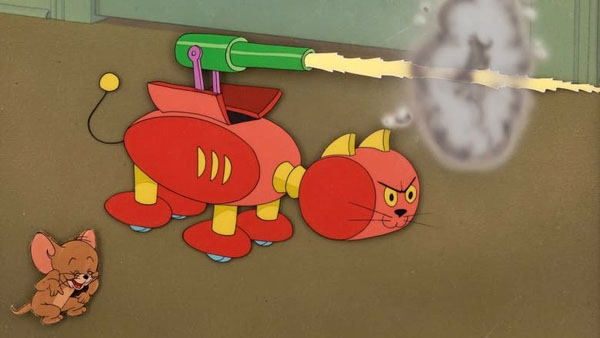 Jerry tries an aerial assault, launching himself into the window by means of a slingshot. Using a ten-foot long extender arm that emerges from Mechano’s jaws, the metal cat makes a perfect catch of Jerry with a baseball fielder’s mitt. Jerry is carried inside Mechano to the window again, where he is shot back outside via a miniature cannon, Jerry next launches a final assault. Mechano may be a match for any one mouse – but what will happen if his circuits get overloaded chasing two, three, four…or even more? Jerry decides to find out – with a box of wind-up toy mice. He sends one after another under the front door, leaving Mechano to discover multiple mice rolling every which way. Mechno literally goes berserk. His cannon fires randomly in all directions. Two robotic arms emerge, swinging meat cleaver and pirate sword. His axe emerges, swinging at air. And a factory whistle blows steam out of his back, signaling he is literally blowing his top. Three metal mice roll up and into the living room piano. Mechano chops entirely through it with his axe. Mechano takes cannon shots as a metal mouse rolls along a china shelf near the ceiling, blasting away all of Mammy’s best dishes. A mouse on the dining table is pursued with a miniature buzz-saw, carving a serpentine path through the high-polished woodwork. Mechano shifts into flying mode, extending his front legs like wings, and dropping four sticks of dynamite as a payload out a bomb bay door, which blast away a corner of Mammy’s walls. Mammy walks in to find her living room a war zone, with Mechano chopping holes in the floor with regular beats of his axe. Worse yet, his pursuit of one mouse changes direction, placing Mammy’s feet in the line of fire of the axe swings. She calls in panicked scream for Tom, who fortunately is still just outside the yard fence. But Tom really doesn’t do anything to save the situation, as Mechano himself begins to self-destruct. He charges through a closed door, losing his head unit. His headless body collides with a wooden desk, knocking away his body sides. And a final collision with a coffee table sends the robot’s power-generator unit flying off its mountings, and sailing across the room. Tom stands open-jawed, as the unit sails right down his throat and into his belly. Mammy appears to welcome Tom back, now happy to just have an old-fashioned cat. But Jerry, having observed what happened to Tom, climbs up to the robot’s remote control, and twists the dial. Tom’s tail rises like Mechano’s at the radio signal. His legs develop the rigidness of the robot, and the power to roll instead of run. Even Tom’s head seems to streamline, so that he now strongly resembles the robot. As one of Jerry’s wind-up decoys rolls by, Tom is off, much to the shock of Mammy, careening around the room and busting furniture and fixtures nearly as badly as Mechano, as we iris out upon the scene of disaster.
Jerry tries an aerial assault, launching himself into the window by means of a slingshot. Using a ten-foot long extender arm that emerges from Mechano’s jaws, the metal cat makes a perfect catch of Jerry with a baseball fielder’s mitt. Jerry is carried inside Mechano to the window again, where he is shot back outside via a miniature cannon, Jerry next launches a final assault. Mechano may be a match for any one mouse – but what will happen if his circuits get overloaded chasing two, three, four…or even more? Jerry decides to find out – with a box of wind-up toy mice. He sends one after another under the front door, leaving Mechano to discover multiple mice rolling every which way. Mechno literally goes berserk. His cannon fires randomly in all directions. Two robotic arms emerge, swinging meat cleaver and pirate sword. His axe emerges, swinging at air. And a factory whistle blows steam out of his back, signaling he is literally blowing his top. Three metal mice roll up and into the living room piano. Mechano chops entirely through it with his axe. Mechano takes cannon shots as a metal mouse rolls along a china shelf near the ceiling, blasting away all of Mammy’s best dishes. A mouse on the dining table is pursued with a miniature buzz-saw, carving a serpentine path through the high-polished woodwork. Mechano shifts into flying mode, extending his front legs like wings, and dropping four sticks of dynamite as a payload out a bomb bay door, which blast away a corner of Mammy’s walls. Mammy walks in to find her living room a war zone, with Mechano chopping holes in the floor with regular beats of his axe. Worse yet, his pursuit of one mouse changes direction, placing Mammy’s feet in the line of fire of the axe swings. She calls in panicked scream for Tom, who fortunately is still just outside the yard fence. But Tom really doesn’t do anything to save the situation, as Mechano himself begins to self-destruct. He charges through a closed door, losing his head unit. His headless body collides with a wooden desk, knocking away his body sides. And a final collision with a coffee table sends the robot’s power-generator unit flying off its mountings, and sailing across the room. Tom stands open-jawed, as the unit sails right down his throat and into his belly. Mammy appears to welcome Tom back, now happy to just have an old-fashioned cat. But Jerry, having observed what happened to Tom, climbs up to the robot’s remote control, and twists the dial. Tom’s tail rises like Mechano’s at the radio signal. His legs develop the rigidness of the robot, and the power to roll instead of run. Even Tom’s head seems to streamline, so that he now strongly resembles the robot. As one of Jerry’s wind-up decoys rolls by, Tom is off, much to the shock of Mammy, careening around the room and busting furniture and fixtures nearly as badly as Mechano, as we iris out upon the scene of disaster.
 Hare Lift (Warner, Bugs Bunny, 12/20/52 – I. (Friz) Freleng, dir.), includes a brief robot cameo. A huge experimental plane gets parked over Bugs’ rabbit hole at an airport, and Bugs decides to take his own tour of the craft when it is left unguarded. Bank robber Yosemite Sam is in search of a quick getaway device, and finds Bugs playing pilot at the control panel of the plane. At gunpoint, he hijacks the plane, ordering Bugs to fly it. (This caused some consternation at local stations for awhile, during the period when airline hijackings were becoming a serious problem, causing the film to be pulled from rotation for a few years, not to give anyone ideas.) Bugs of course doesn’t know the first thing about flying, but Sam is too stubborn to notice until they are already airborne, and Bugs’ erratic piloting style tosses Sam all over the place inside the airship. In desperation, as the plane’s steering wheel is thrown out the window by Bugs, Sam pushes a button reading “Robot Pilot”. Out of a closet emerges our pole-head robot from “Dog-Gone Modern” and “House Hunting Mice”, this time with legs instead of wheels and a dustpan. The metal man takes one look around to assess the situation, and wisely recognizes when the time is right to desert a sinking ship. It runs for the parachute rack, straps on a chute, and hits the silk out the cabin door, the chute billowing out as it descends slowly to the ground. Bugs and Sam are left with the dilemma of only one parachute with two passengers. Bugs suggests they draw straws for it. Yosemite replies, “You draw the straws – I’m a-takin’ the parachute!” Grabbing his bag of stolen bank money, Yosemite hops out with a call of “Geronimo”, waving goodbye to Bugs with an evil grin. His landing is not so happy, however, as he touches down right in the middle of some cops in an open-top parade car. Bugs meanwhile pulls on a large lever in the cockpit, which miraculously causes the plane to screech to a stop in mid-air, only a few feet above the ground. “Whew! Lucky for me this thing had air brakes!”
Hare Lift (Warner, Bugs Bunny, 12/20/52 – I. (Friz) Freleng, dir.), includes a brief robot cameo. A huge experimental plane gets parked over Bugs’ rabbit hole at an airport, and Bugs decides to take his own tour of the craft when it is left unguarded. Bank robber Yosemite Sam is in search of a quick getaway device, and finds Bugs playing pilot at the control panel of the plane. At gunpoint, he hijacks the plane, ordering Bugs to fly it. (This caused some consternation at local stations for awhile, during the period when airline hijackings were becoming a serious problem, causing the film to be pulled from rotation for a few years, not to give anyone ideas.) Bugs of course doesn’t know the first thing about flying, but Sam is too stubborn to notice until they are already airborne, and Bugs’ erratic piloting style tosses Sam all over the place inside the airship. In desperation, as the plane’s steering wheel is thrown out the window by Bugs, Sam pushes a button reading “Robot Pilot”. Out of a closet emerges our pole-head robot from “Dog-Gone Modern” and “House Hunting Mice”, this time with legs instead of wheels and a dustpan. The metal man takes one look around to assess the situation, and wisely recognizes when the time is right to desert a sinking ship. It runs for the parachute rack, straps on a chute, and hits the silk out the cabin door, the chute billowing out as it descends slowly to the ground. Bugs and Sam are left with the dilemma of only one parachute with two passengers. Bugs suggests they draw straws for it. Yosemite replies, “You draw the straws – I’m a-takin’ the parachute!” Grabbing his bag of stolen bank money, Yosemite hops out with a call of “Geronimo”, waving goodbye to Bugs with an evil grin. His landing is not so happy, however, as he touches down right in the middle of some cops in an open-top parade car. Bugs meanwhile pulls on a large lever in the cockpit, which miraculously causes the plane to screech to a stop in mid-air, only a few feet above the ground. “Whew! Lucky for me this thing had air brakes!”
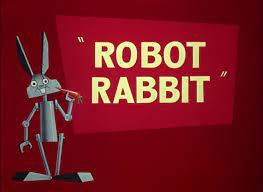 Robot Rabbit (Warner, Bugs Bunny, 12/12/53 – I. (Friz) Freleng, dir.) – This film feels as though it shares a commonality with Friz’s “Rabbit Every Monday” of a few seasons earlier – falling short on enough solid plot material to sustain its full running length, and so filling with “personality” material for its early scenes, making only slight variants from familiar routines we all know and associate with the interplay of Bugs and Elmer. In fact, it even borrows a few bars from the former film to have Bugs reprise a custom-lyric rendition of Doris Day’s hit, “It’s Magic”. Nevertheless, what portions of the film are plot driven prove to be fun. Carl Stalling sets the mood with a tongue-in-cheek rendition of Bugs’ theme song, “What’s Up Doc?”, containing all kinds of clinkers, odd key changes, and mechanized-sounding discords, which is a highlight in and of itself. Elmer finds Bugs raiding the carrot patch again, and calls Acme Pest Control (a division of Wile E. Coyote’s supply house?) about a pest that needs control. They send him their latest innovation – a “wobot pest contwoller with an electwonic bwain”. The machine’s body and head amount to three cylindrical drums of decreasing diameters, stacked one atop the other. The topmost serves as the head, and has two large protruding bulbs shaped like old-time radio tubes for eyes, and an even larger one sticking out of its top. An instruction sheet informs Elmer to identify the pest he wants controlled by inserting a picture into a slot on the robot’s chest. Elmer inserts an illustration of a long-eared rabbit, and the machine vibrates to life, setting off upon unseen roller wheels into the farmyard in search of its prey. It appears, however, that the only identifying feature which the robot comprehends is long ears, as he approaches the barn where a long-eared mule is corralled.
Robot Rabbit (Warner, Bugs Bunny, 12/12/53 – I. (Friz) Freleng, dir.) – This film feels as though it shares a commonality with Friz’s “Rabbit Every Monday” of a few seasons earlier – falling short on enough solid plot material to sustain its full running length, and so filling with “personality” material for its early scenes, making only slight variants from familiar routines we all know and associate with the interplay of Bugs and Elmer. In fact, it even borrows a few bars from the former film to have Bugs reprise a custom-lyric rendition of Doris Day’s hit, “It’s Magic”. Nevertheless, what portions of the film are plot driven prove to be fun. Carl Stalling sets the mood with a tongue-in-cheek rendition of Bugs’ theme song, “What’s Up Doc?”, containing all kinds of clinkers, odd key changes, and mechanized-sounding discords, which is a highlight in and of itself. Elmer finds Bugs raiding the carrot patch again, and calls Acme Pest Control (a division of Wile E. Coyote’s supply house?) about a pest that needs control. They send him their latest innovation – a “wobot pest contwoller with an electwonic bwain”. The machine’s body and head amount to three cylindrical drums of decreasing diameters, stacked one atop the other. The topmost serves as the head, and has two large protruding bulbs shaped like old-time radio tubes for eyes, and an even larger one sticking out of its top. An instruction sheet informs Elmer to identify the pest he wants controlled by inserting a picture into a slot on the robot’s chest. Elmer inserts an illustration of a long-eared rabbit, and the machine vibrates to life, setting off upon unseen roller wheels into the farmyard in search of its prey. It appears, however, that the only identifying feature which the robot comprehends is long ears, as he approaches the barn where a long-eared mule is corralled.
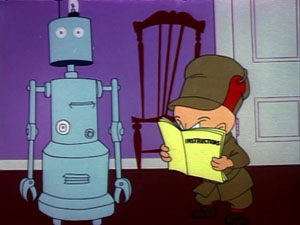 The robot retracts one of its claw-like hands into its metal arm, then replaces the attachment with a futuristic ray gun. The robot blasts the mule in the face, shearing bare the mule’s entire head of all fur. “What’d I do? What’d I do?”, complains the mule. “No, no, you stupid wobot”, shouts Elmer, as he attempts to illustrate to the device what a real rabbit looks like, by grabbing a few leaves off a nearby plant to resemble rabbit ears on his head, and hopping around and around. Elmer’s a reasonable-enough facsimile for the robot’s tastes – and gets blasted by the ray gun too. Finally, the confusion is cleared up, as Bugs saunters into the yard. The robot’s head-bulb flashes red in recognition, and the machine quickly rolls up to Bugs, bumping him squarely in the chest to push him back a step. “Watch where you’re goin’, ya’ hot water heater”, snarls Bugs. But the robot repeats the bump again. “Why you fugitive from a Stanley Steamer! I’ve got a notion to take you apart with a screwdriver.” The robot retracts one claw into its arm again, producing as a new attachment – a boxing glove. He takes a sock at Bugs, but Bugs’ position is just beyond the robot’s arm reach. Bugs rears back to take a swing at the robot himself, but the machine has a further trick up its sleeve, as the boxing glove suddenly projects out from its arm on the end of a coiled spring, delivering Bugs a left to the jaw. Staggering, Bugs regains his bearings long enough to dive into his rabbit hole. The robot changes attachments again, replacing his right claw with a miniature version of a construction crane claw digger. The robot drops the construction claw over Bugs’ hole, then lifts the dirt of the entire hole out of the ground, depositing it into a gold-miner’s sifting box. In a shot lifted from “14 Carrot Rabbit”, the robot shakes the sifting box until all the dirt falls out of the metal mesh at its base, leaving Bugs revealed. Bugs resumes a trotting retreat across the farm, commenting to the audience. “I can see this cigarette machine is gonna cause me no end of trouble.” Bugs spots a lawn sprinkler in front of Elmer’s house, slowly rotating to spray a stream of water along a circular path. Bugs runs into the orbit of the water, just ahead of the sprinkler’s flow, allowing the robot to bring up the rear, rolling directly in the path of the water as the robot and Bugs circle round and round. It isn’t long before the robot’s metal begins to display patches of brown rust, and the robot slows to a standstill, motionless in its tracks. Elmer is forced to assume the same role as Dorothy in The Wizard of Oz, retrieving an oil can to get the tin man going again.
The robot retracts one of its claw-like hands into its metal arm, then replaces the attachment with a futuristic ray gun. The robot blasts the mule in the face, shearing bare the mule’s entire head of all fur. “What’d I do? What’d I do?”, complains the mule. “No, no, you stupid wobot”, shouts Elmer, as he attempts to illustrate to the device what a real rabbit looks like, by grabbing a few leaves off a nearby plant to resemble rabbit ears on his head, and hopping around and around. Elmer’s a reasonable-enough facsimile for the robot’s tastes – and gets blasted by the ray gun too. Finally, the confusion is cleared up, as Bugs saunters into the yard. The robot’s head-bulb flashes red in recognition, and the machine quickly rolls up to Bugs, bumping him squarely in the chest to push him back a step. “Watch where you’re goin’, ya’ hot water heater”, snarls Bugs. But the robot repeats the bump again. “Why you fugitive from a Stanley Steamer! I’ve got a notion to take you apart with a screwdriver.” The robot retracts one claw into its arm again, producing as a new attachment – a boxing glove. He takes a sock at Bugs, but Bugs’ position is just beyond the robot’s arm reach. Bugs rears back to take a swing at the robot himself, but the machine has a further trick up its sleeve, as the boxing glove suddenly projects out from its arm on the end of a coiled spring, delivering Bugs a left to the jaw. Staggering, Bugs regains his bearings long enough to dive into his rabbit hole. The robot changes attachments again, replacing his right claw with a miniature version of a construction crane claw digger. The robot drops the construction claw over Bugs’ hole, then lifts the dirt of the entire hole out of the ground, depositing it into a gold-miner’s sifting box. In a shot lifted from “14 Carrot Rabbit”, the robot shakes the sifting box until all the dirt falls out of the metal mesh at its base, leaving Bugs revealed. Bugs resumes a trotting retreat across the farm, commenting to the audience. “I can see this cigarette machine is gonna cause me no end of trouble.” Bugs spots a lawn sprinkler in front of Elmer’s house, slowly rotating to spray a stream of water along a circular path. Bugs runs into the orbit of the water, just ahead of the sprinkler’s flow, allowing the robot to bring up the rear, rolling directly in the path of the water as the robot and Bugs circle round and round. It isn’t long before the robot’s metal begins to display patches of brown rust, and the robot slows to a standstill, motionless in its tracks. Elmer is forced to assume the same role as Dorothy in The Wizard of Oz, retrieving an oil can to get the tin man going again.
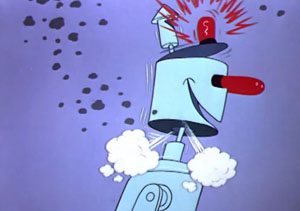 The robot searches for Bugs around an old tool shed. Meanwhile, Bugs inside paints feminine eyes and lips upon an old metal pail, then dons a pot-bellied stove in the manner of a suit of armor. He appears out the door of the shed in the guise of a female robot, flirting with Elmer’s device, and shaking about his stove-metal as if displaying a shapely rear. The real robot’s lights all turn red, and he develops for the only time in the film a mouth, open with a wide broad smile. The robot zooms over to Bugs, and offers “her” a candy box, labeled “Assorted Nuts”. Lifting the box lid, the contents prove to take the label literally – consisting of metal “nuts” without bolts. The robot picks the Bugs-bot up in his arms, while Bugs coyly complains that he’s playing it “too fast”. In reality, the rabbit has his own plan hatching, as he produces a monkey wrench, reaches to open a hatch panel in the back side of the robot’s body, and tosses the wrench into the robot’s internal machinery. The robot sputters, jerks, and its lower cylinder splits down the middle and falls away from its body, revealing the robot’s hidden spindly leg-supports. The base of its second cylinder falls off and past its metal ankles to ground level, revealing momentarily the robot’s whirring engine as if upon a pair of fallen pants. The robot picks up the engine and base, hoisting them back into position, while posing to the camera in a manner suggesting the embarrassment of being caught with its pants down. Finally, in a setup partially lifted from a Tweety and Sylvester film, Bugs leads the robot on a chases back and forth under the rising and falling weight of a construction yard pile driver nearby. As Freleng was so wont to do, we don’t see any actual impact. Instead, we dissolve back to Elmer’s living room, where he is pacing and waiting to find out how his robot made out. Bugs knocks on his door. “Does this answer your question?”, replies Bugs, emptying out before Elmer a can full of crushed robot parts. Bugs departs, uttering aloud the thought, “You know, someday these scientists are gonna invent something that will outsmart a rabbit.”
The robot searches for Bugs around an old tool shed. Meanwhile, Bugs inside paints feminine eyes and lips upon an old metal pail, then dons a pot-bellied stove in the manner of a suit of armor. He appears out the door of the shed in the guise of a female robot, flirting with Elmer’s device, and shaking about his stove-metal as if displaying a shapely rear. The real robot’s lights all turn red, and he develops for the only time in the film a mouth, open with a wide broad smile. The robot zooms over to Bugs, and offers “her” a candy box, labeled “Assorted Nuts”. Lifting the box lid, the contents prove to take the label literally – consisting of metal “nuts” without bolts. The robot picks the Bugs-bot up in his arms, while Bugs coyly complains that he’s playing it “too fast”. In reality, the rabbit has his own plan hatching, as he produces a monkey wrench, reaches to open a hatch panel in the back side of the robot’s body, and tosses the wrench into the robot’s internal machinery. The robot sputters, jerks, and its lower cylinder splits down the middle and falls away from its body, revealing the robot’s hidden spindly leg-supports. The base of its second cylinder falls off and past its metal ankles to ground level, revealing momentarily the robot’s whirring engine as if upon a pair of fallen pants. The robot picks up the engine and base, hoisting them back into position, while posing to the camera in a manner suggesting the embarrassment of being caught with its pants down. Finally, in a setup partially lifted from a Tweety and Sylvester film, Bugs leads the robot on a chases back and forth under the rising and falling weight of a construction yard pile driver nearby. As Freleng was so wont to do, we don’t see any actual impact. Instead, we dissolve back to Elmer’s living room, where he is pacing and waiting to find out how his robot made out. Bugs knocks on his door. “Does this answer your question?”, replies Bugs, emptying out before Elmer a can full of crushed robot parts. Bugs departs, uttering aloud the thought, “You know, someday these scientists are gonna invent something that will outsmart a rabbit.”
 Design for Leaving (Warner, Daffy Duck, 3/27/54 – Robert McKimson, dir.), has been visited several times before. Fast-talking sales-duck Daffy is pushing a line of Acme Futuramic push-button household appliances, that literally take a dump truck to hold, requiring the temporary eviction of the homeowner in order to install them all for a free home demonstration. Daffy accomplishes this by re-routing Elmer from his daily trip to work, onto a bus running non-stop to Duluth. When Elmer returns, a motorized hat rack takes his hat and coat at the door with robotic arms. A “relaxing chair” (which instead rolls Elmer up like a jelly roll) offers Elmer a mellow cigar with more robotic hands, but lighting it triggers an ultra-sensitive robot fire extinguisher – our same pole-headed robot from the previous Chuck Jones films, wearing a fireman’s helmet and alarm bell on its chest, carrying a bucket of water to drench Elmer as he sits. A bricklaying robot provides a solution to dirty windows, building a brick wall to cover their view entirely. A robot dog serves as a deterrent to burglars, but instead chomps upon the ankle of the fellow pushing his activation button. An automatic tie-knotter will tie any knot that you want – and some that you don’t, as a pair of robotic hands fashions Elmer’s tie into a hangman’s noose, which Daffy refers to as the “Alcatraz Ascot.” Elmer finally fights fire with fire, actually purchasing over the phone from Daffy’s supply house an Acme Futuramic salesman ejector – another variant upon the pole robot, featuring a large hinged forward leg wearing an oversized army boot, with which it beats a staccato on Daffy’s rear end while hustling the duck out the door.
Design for Leaving (Warner, Daffy Duck, 3/27/54 – Robert McKimson, dir.), has been visited several times before. Fast-talking sales-duck Daffy is pushing a line of Acme Futuramic push-button household appliances, that literally take a dump truck to hold, requiring the temporary eviction of the homeowner in order to install them all for a free home demonstration. Daffy accomplishes this by re-routing Elmer from his daily trip to work, onto a bus running non-stop to Duluth. When Elmer returns, a motorized hat rack takes his hat and coat at the door with robotic arms. A “relaxing chair” (which instead rolls Elmer up like a jelly roll) offers Elmer a mellow cigar with more robotic hands, but lighting it triggers an ultra-sensitive robot fire extinguisher – our same pole-headed robot from the previous Chuck Jones films, wearing a fireman’s helmet and alarm bell on its chest, carrying a bucket of water to drench Elmer as he sits. A bricklaying robot provides a solution to dirty windows, building a brick wall to cover their view entirely. A robot dog serves as a deterrent to burglars, but instead chomps upon the ankle of the fellow pushing his activation button. An automatic tie-knotter will tie any knot that you want – and some that you don’t, as a pair of robotic hands fashions Elmer’s tie into a hangman’s noose, which Daffy refers to as the “Alcatraz Ascot.” Elmer finally fights fire with fire, actually purchasing over the phone from Daffy’s supply house an Acme Futuramic salesman ejector – another variant upon the pole robot, featuring a large hinged forward leg wearing an oversized army boot, with which it beats a staccato on Daffy’s rear end while hustling the duck out the door.
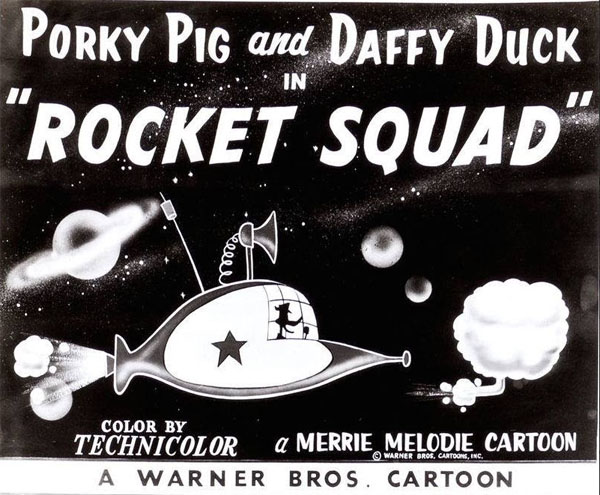 Rocket Squad (Warner, Porky and Daffy, 3/10/56 – Chuck Jones, dir.) – This film takes inspiration in equal parts from television and radio’s popular “Dragnet” series, and Jones’ own futuristic spoof, “Duck Dodgers in the 24th 1/2 Century”, by transposing the basic setup of a Dragnet police-investigation episode into the interplanetary future of outer space. The title, in turn, parodies another popular police drama of the period, “Racket Squad.”
Rocket Squad (Warner, Porky and Daffy, 3/10/56 – Chuck Jones, dir.) – This film takes inspiration in equal parts from television and radio’s popular “Dragnet” series, and Jones’ own futuristic spoof, “Duck Dodgers in the 24th 1/2 Century”, by transposing the basic setup of a Dragnet police-investigation episode into the interplanetary future of outer space. The title, in turn, parodies another popular police drama of the period, “Racket Squad.”
The standard Dragnet opening is parodied by an intertitle, reading “The story you are about to see is true. Only the drawings have been changed to protect the innocent.” Amidst floating traffic signs warning not to exceed 55,000 MPH, a patrol rocket prowls the skies, piloted by Officers Joe Monday (Daffy) and Shmoe Tuesday (Porky – “He always follows me”). They are returning from an investigation of malicious mischief – school children have blown the rings off of Saturn. “When will parents learn to keep uranium out of their children’s reach?” They report to headquarters, where a giant robotic eye (first seen in “Duck Dodgers”) pivots above them to view their entrance. The boys reach their office floor via a vacuum-tube system predating George Jetson by about five years, but using the department store idea of traveling within the tube inside a metal cylinder. A robotic arm inserts their cylinder into the proper tube, where it zigs, zags, and violently bounces in a maze-like path to the upper floors, another robotic arm picking up the cylinder on the floor above and shaking the passengers out as if they were unwanted specks of dust. Porky and Daffy, battered and somewhat shorter in stature than they began, stumble to their office, while Porky comments, “Isn’t m-modern science wonderful? P-people used to have to use stairs.”
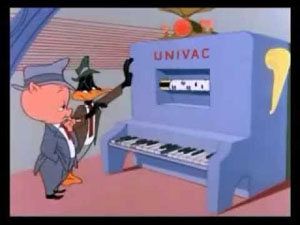 The boys are sent “To Scene of Crime” via evaporator booth (another Duck Dodgers innovation), where they observe the crime robots in action, pushing a device resembling a vacuum cleaner marked “Clue Collector” – capable of even sucking up footprints from a carpet. Our heroes return again to headquarters with a sack of the found clues, and pour the contents into another mechanical device, which subjects the contents to analysis by “all the facilities of a modern crime lab.” A number of IBM punch cards are generated by the machinery, and a pair of robot hands holds them up like a card dealer, while another robotic arm selects one from the deck, and shoots it out to Porky. Porky takes the perforated card, and spools it around the cylinder of a Univac computer, in the manner of a player piano roll. The card begins to rotate, playing on an attached piano keyboard the tune “Mother Machree.” The name matches the alias of a “criminal” in police files – a villain so clever, he has never been suspected of anything. Another device with separate typewriter keys identifying known criminals (other keys marked C.M. Jones, Tedd Pierce, Eddie Selzer, John Burton, Norman Moray, and Mel Blanc) provides Machree’s current location. A space chase passes through a car-hop restaurant catering to flying saucers, and into a smogbank over Los Angeles, where Machree’s rocket=car is cornered in a cloud disguise. Machree, like all criminals, has an elaborate alibi – “I didn’t do nothin’!” Turns out he’s correct, as the cartoon closes with Daffy and Porky sentenced themselves to 30 years in prison for false arrest. At least the future seems to hold swift justice against bad cops.
The boys are sent “To Scene of Crime” via evaporator booth (another Duck Dodgers innovation), where they observe the crime robots in action, pushing a device resembling a vacuum cleaner marked “Clue Collector” – capable of even sucking up footprints from a carpet. Our heroes return again to headquarters with a sack of the found clues, and pour the contents into another mechanical device, which subjects the contents to analysis by “all the facilities of a modern crime lab.” A number of IBM punch cards are generated by the machinery, and a pair of robot hands holds them up like a card dealer, while another robotic arm selects one from the deck, and shoots it out to Porky. Porky takes the perforated card, and spools it around the cylinder of a Univac computer, in the manner of a player piano roll. The card begins to rotate, playing on an attached piano keyboard the tune “Mother Machree.” The name matches the alias of a “criminal” in police files – a villain so clever, he has never been suspected of anything. Another device with separate typewriter keys identifying known criminals (other keys marked C.M. Jones, Tedd Pierce, Eddie Selzer, John Burton, Norman Moray, and Mel Blanc) provides Machree’s current location. A space chase passes through a car-hop restaurant catering to flying saucers, and into a smogbank over Los Angeles, where Machree’s rocket=car is cornered in a cloud disguise. Machree, like all criminals, has an elaborate alibi – “I didn’t do nothin’!” Turns out he’s correct, as the cartoon closes with Daffy and Porky sentenced themselves to 30 years in prison for false arrest. At least the future seems to hold swift justice against bad cops.
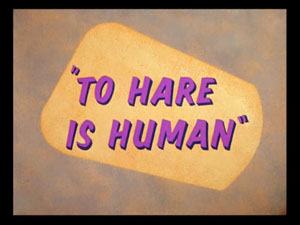 To Hare Is Human (Warner, Bugs Bunny, 12/15/56 – Chuck Jones, dir.) – Wile E.’s back, and Bugs has got him. Instead of a portable door, Wile E. Gains entry to Bugs’ hole with a folding elevator – intil Bugs rigs both the coyote’s sack and his elevator car with dynamite. This time, however, Wile E’s through straining his superior brain. Instead, he’s willing to take advice from a Univac Electronic Brain (Do It Yourself Kit) – an early-day supercomputer. The devicehas no end of keys to push on a control panel, One series of buttons list about every animal species known to man – Wile E. selects “Rabbit”. A second batch of switches lists habitats and locales, including “in hole”. A third set of controls lists every king of lock, including “combination lock”, which Bugs has just installed on gis hole. The machine shoots out an answer on a strip of paper, indicating “Entree may be gained using burglary methods” – and provides the combination to Bugs’ lock! Wile E. Sneaks in by night, carrying burglary methods to extremes by supplying his own folding wall with window, just so he can pry the window open to get “inside” where the lock is. As the coyote begins twisting the lock dial, Bugs below hears the tumblers of the lock clicking. Using a small hammer, he breaks the glass on a wall emergency box reading, “In case of coyote, break glass.” Inside rests a simple banana peel, which Bugs tosses at the feet of the ladder leading down into his rabbit hole. Wile E. Gains entry to the hole, climbs down the ladder, and immediately slips on the banana peel. He soars across the room, directly into a metal chute labeled “Coyote Disposal”. The chute slides him out an exit through a hole in the side of a cliff, leaving Wile E. In mud air, to fall into a deep canyon in traditional fashion.
To Hare Is Human (Warner, Bugs Bunny, 12/15/56 – Chuck Jones, dir.) – Wile E.’s back, and Bugs has got him. Instead of a portable door, Wile E. Gains entry to Bugs’ hole with a folding elevator – intil Bugs rigs both the coyote’s sack and his elevator car with dynamite. This time, however, Wile E’s through straining his superior brain. Instead, he’s willing to take advice from a Univac Electronic Brain (Do It Yourself Kit) – an early-day supercomputer. The devicehas no end of keys to push on a control panel, One series of buttons list about every animal species known to man – Wile E. selects “Rabbit”. A second batch of switches lists habitats and locales, including “in hole”. A third set of controls lists every king of lock, including “combination lock”, which Bugs has just installed on gis hole. The machine shoots out an answer on a strip of paper, indicating “Entree may be gained using burglary methods” – and provides the combination to Bugs’ lock! Wile E. Sneaks in by night, carrying burglary methods to extremes by supplying his own folding wall with window, just so he can pry the window open to get “inside” where the lock is. As the coyote begins twisting the lock dial, Bugs below hears the tumblers of the lock clicking. Using a small hammer, he breaks the glass on a wall emergency box reading, “In case of coyote, break glass.” Inside rests a simple banana peel, which Bugs tosses at the feet of the ladder leading down into his rabbit hole. Wile E. Gains entry to the hole, climbs down the ladder, and immediately slips on the banana peel. He soars across the room, directly into a metal chute labeled “Coyote Disposal”. The chute slides him out an exit through a hole in the side of a cliff, leaving Wile E. In mud air, to fall into a deep canyon in traditional fashion.
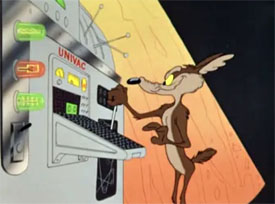 An x-ray TV viewer next reveals Bugs in his kitchen, placing two carrots in a toaster. Wile E. Enters “breakfast”, “Toaster”, “Carrots” as data into the machine, and gets the answer: “Substitute hand grenades for carrots in toaster.” With fishing lines from the entrance to Bugs’s hole (now minus its combination lock), Wile E. Hooks the two carrots, pulling them out of the toaster, then drops two live grenades into the toaster holes in their place. As Bugs re=enters the kitchen, the spring of the toaster ejects the grenades – up into the air several feet, and out the rabbit hole, where they deliver Wile E. The force of a double blast. Below, Bugs comments, “One of these days, I’m gonna have to have that spring fixed.”
An x-ray TV viewer next reveals Bugs in his kitchen, placing two carrots in a toaster. Wile E. Enters “breakfast”, “Toaster”, “Carrots” as data into the machine, and gets the answer: “Substitute hand grenades for carrots in toaster.” With fishing lines from the entrance to Bugs’s hole (now minus its combination lock), Wile E. Hooks the two carrots, pulling them out of the toaster, then drops two live grenades into the toaster holes in their place. As Bugs re=enters the kitchen, the spring of the toaster ejects the grenades – up into the air several feet, and out the rabbit hole, where they deliver Wile E. The force of a double blast. Below, Bugs comments, “One of these days, I’m gonna have to have that spring fixed.”
The fingers of Wile E. Press from three more series of buttons, the words “What” “Now” “?”. With no more detailed information, the Univac begins supplying random suggestions, including use of a suction plunger (which Wile E. is sucked into himself via a pipe run outside from Bugs’ hole), a dynamite stick in a vacuum cleaner (which backfires when Bugs empties out the vacuum bag into a trash can in which Wile E. is hiding), and a booby trap in the carrot patch, consisting of a boulder held above by a trigger-rope tied to a carrot. Bugs plucks the carrot from the rope without disturbing the boulder one bit, but Wile E.’s slightest touch sends it falling, its shadow descending upon the spot where they coyote stands. The coyote sensibly dicks out of harms’ way, and retreats to his cave to consult the computer again. He enters the words, “Rock” “Falling” – “What’ll” “I’ “Do?”. The paper tape shoots out the odd advice, “Go back and take your medicine.” In obedient, unthinking compliance, the coyote runs back outside, and stands directly in the path of the oncoming boulder shadow, allowing the rock to crush him. Back inside Wile E.’s cave, a panel on the Univac opens, revealing inside – Bugs. The rabbit addresses the audience through the hatch = “Of course. The real beauty of this machine is that it has only one moving part.” Guess who?
More theatrical tin men – and women – as we move into the 1960’s, next time.

